Analyzing Power Dynamics in Organizational Development and Change
VerifiedAdded on 2021/04/17
|11
|2864
|198
Essay
AI Summary
This essay delves into the critical role of power dynamics within organizational change, examining both the positive and negative aspects of its application. It begins by defining power and its various forms, including expert, informational, reward, referent, and legitimate power, and how these can be utilized to drive change. The essay then contrasts the positive and negative impacts of power on organizational outcomes, highlighting how effective leadership fosters growth, while negative power can lead to conflict and attrition. A significant portion of the essay is dedicated to exploring Hofstede's cultural dimensions model, analyzing how factors like power distance, individualism, masculinity, and uncertainty avoidance influence the implementation and acceptance of power in different cultural contexts. The essay culminates in a comparative analysis of Australia and Singapore, illustrating how their distinct cultural profiles, as defined by Hofstede's model, shape power dynamics within their respective organizational landscapes. The essay provides valuable insights for organizations seeking to understand and navigate the complexities of power and culture in their change initiatives.
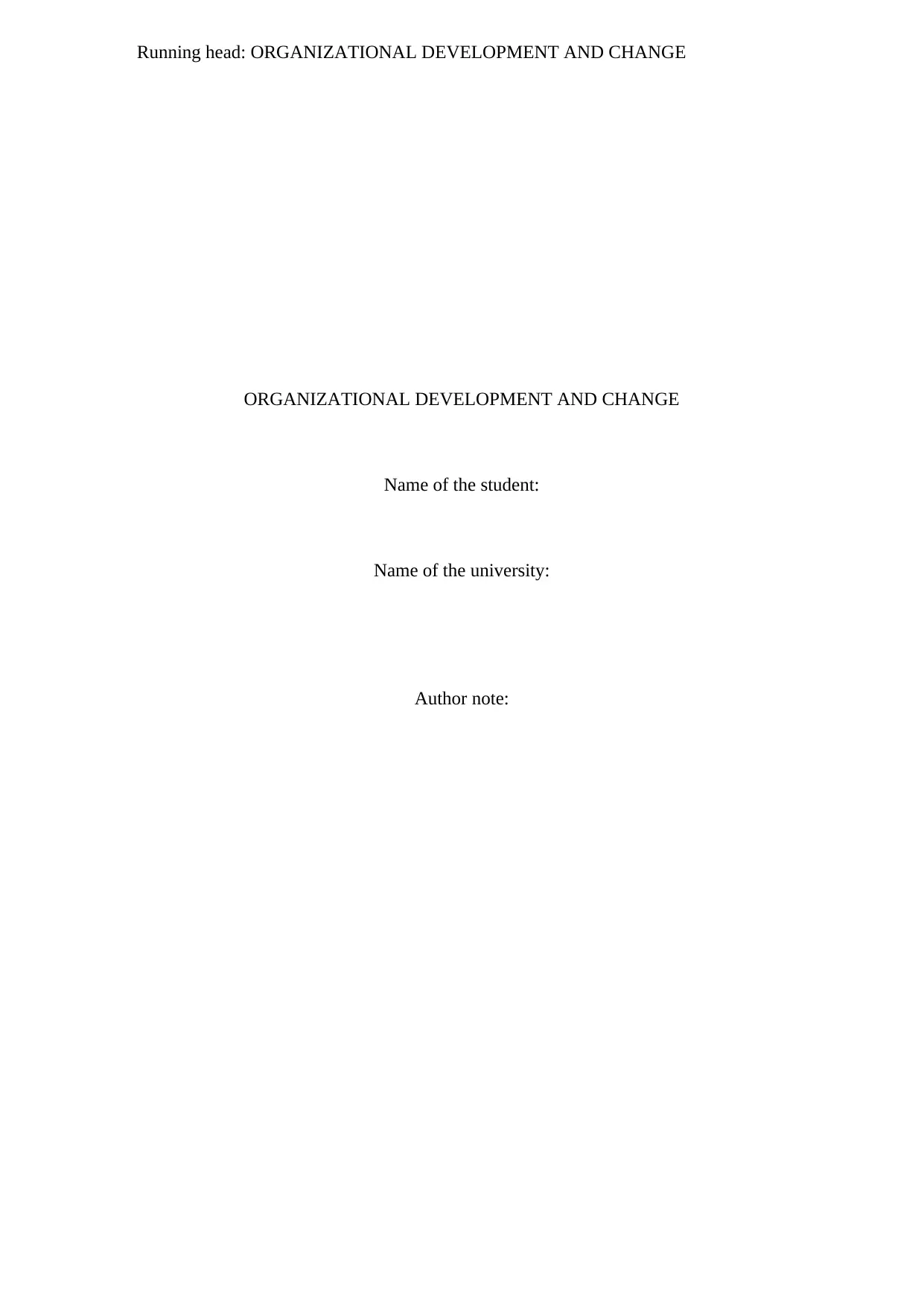
Running head: ORGANIZATIONAL DEVELOPMENT AND CHANGE
ORGANIZATIONAL DEVELOPMENT AND CHANGE
Name of the student:
Name of the university:
Author note:
ORGANIZATIONAL DEVELOPMENT AND CHANGE
Name of the student:
Name of the university:
Author note:
Paraphrase This Document
Need a fresh take? Get an instant paraphrase of this document with our AI Paraphraser
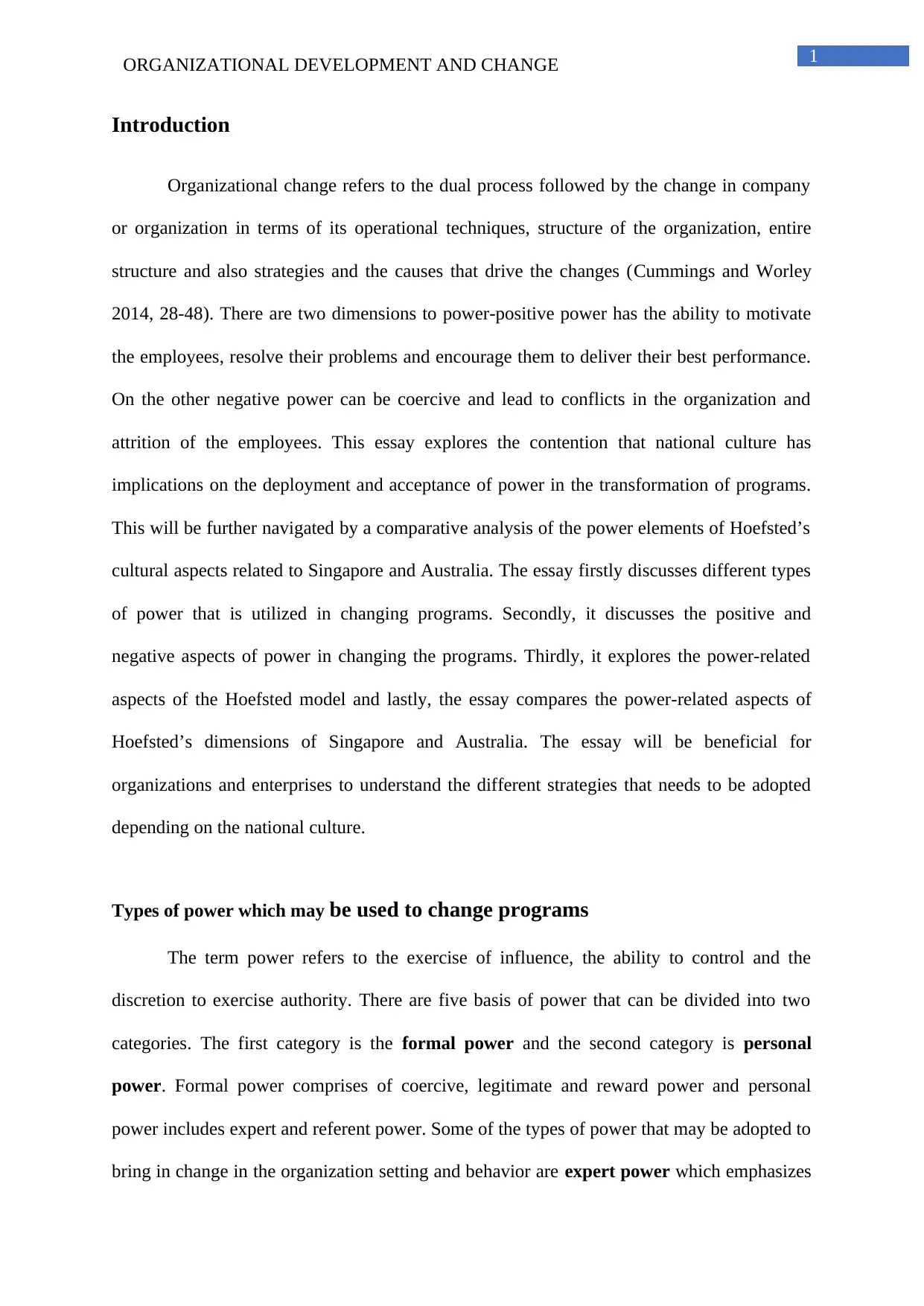
1ORGANIZATIONAL DEVELOPMENT AND CHANGE
Introduction
Organizational change refers to the dual process followed by the change in company
or organization in terms of its operational techniques, structure of the organization, entire
structure and also strategies and the causes that drive the changes (Cummings and Worley
2014, 28-48). There are two dimensions to power-positive power has the ability to motivate
the employees, resolve their problems and encourage them to deliver their best performance.
On the other negative power can be coercive and lead to conflicts in the organization and
attrition of the employees. This essay explores the contention that national culture has
implications on the deployment and acceptance of power in the transformation of programs.
This will be further navigated by a comparative analysis of the power elements of Hoefsted’s
cultural aspects related to Singapore and Australia. The essay firstly discusses different types
of power that is utilized in changing programs. Secondly, it discusses the positive and
negative aspects of power in changing the programs. Thirdly, it explores the power-related
aspects of the Hoefsted model and lastly, the essay compares the power-related aspects of
Hoefsted’s dimensions of Singapore and Australia. The essay will be beneficial for
organizations and enterprises to understand the different strategies that needs to be adopted
depending on the national culture.
Types of power which may be used to change programs
The term power refers to the exercise of influence, the ability to control and the
discretion to exercise authority. There are five basis of power that can be divided into two
categories. The first category is the formal power and the second category is personal
power. Formal power comprises of coercive, legitimate and reward power and personal
power includes expert and referent power. Some of the types of power that may be adopted to
bring in change in the organization setting and behavior are expert power which emphasizes
Introduction
Organizational change refers to the dual process followed by the change in company
or organization in terms of its operational techniques, structure of the organization, entire
structure and also strategies and the causes that drive the changes (Cummings and Worley
2014, 28-48). There are two dimensions to power-positive power has the ability to motivate
the employees, resolve their problems and encourage them to deliver their best performance.
On the other negative power can be coercive and lead to conflicts in the organization and
attrition of the employees. This essay explores the contention that national culture has
implications on the deployment and acceptance of power in the transformation of programs.
This will be further navigated by a comparative analysis of the power elements of Hoefsted’s
cultural aspects related to Singapore and Australia. The essay firstly discusses different types
of power that is utilized in changing programs. Secondly, it discusses the positive and
negative aspects of power in changing the programs. Thirdly, it explores the power-related
aspects of the Hoefsted model and lastly, the essay compares the power-related aspects of
Hoefsted’s dimensions of Singapore and Australia. The essay will be beneficial for
organizations and enterprises to understand the different strategies that needs to be adopted
depending on the national culture.
Types of power which may be used to change programs
The term power refers to the exercise of influence, the ability to control and the
discretion to exercise authority. There are five basis of power that can be divided into two
categories. The first category is the formal power and the second category is personal
power. Formal power comprises of coercive, legitimate and reward power and personal
power includes expert and referent power. Some of the types of power that may be adopted to
bring in change in the organization setting and behavior are expert power which emphasizes
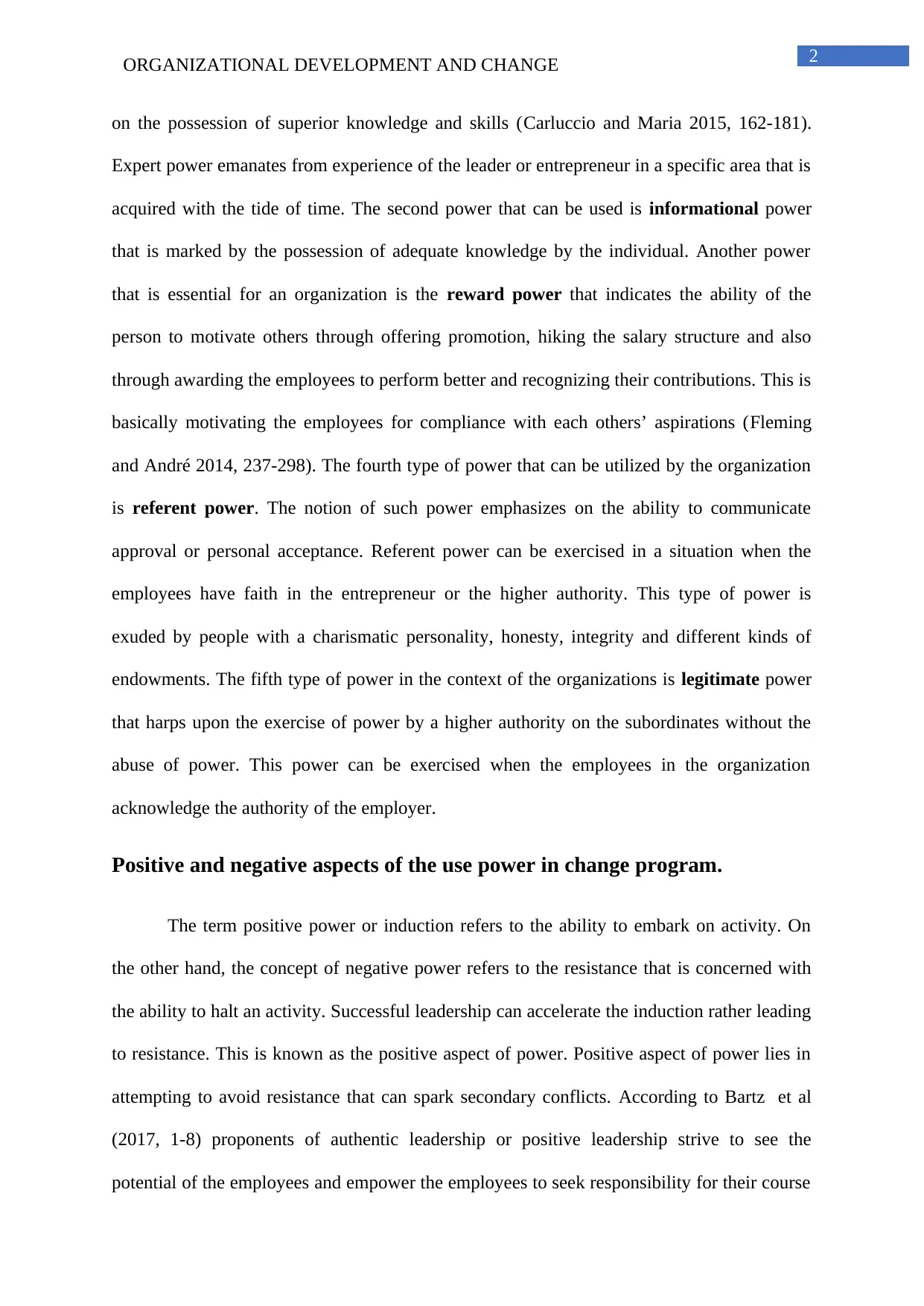
2ORGANIZATIONAL DEVELOPMENT AND CHANGE
on the possession of superior knowledge and skills (Carluccio and Maria 2015, 162-181).
Expert power emanates from experience of the leader or entrepreneur in a specific area that is
acquired with the tide of time. The second power that can be used is informational power
that is marked by the possession of adequate knowledge by the individual. Another power
that is essential for an organization is the reward power that indicates the ability of the
person to motivate others through offering promotion, hiking the salary structure and also
through awarding the employees to perform better and recognizing their contributions. This is
basically motivating the employees for compliance with each others’ aspirations (Fleming
and André 2014, 237-298). The fourth type of power that can be utilized by the organization
is referent power. The notion of such power emphasizes on the ability to communicate
approval or personal acceptance. Referent power can be exercised in a situation when the
employees have faith in the entrepreneur or the higher authority. This type of power is
exuded by people with a charismatic personality, honesty, integrity and different kinds of
endowments. The fifth type of power in the context of the organizations is legitimate power
that harps upon the exercise of power by a higher authority on the subordinates without the
abuse of power. This power can be exercised when the employees in the organization
acknowledge the authority of the employer.
Positive and negative aspects of the use power in change program.
The term positive power or induction refers to the ability to embark on activity. On
the other hand, the concept of negative power refers to the resistance that is concerned with
the ability to halt an activity. Successful leadership can accelerate the induction rather leading
to resistance. This is known as the positive aspect of power. Positive aspect of power lies in
attempting to avoid resistance that can spark secondary conflicts. According to Bartz et al
(2017, 1-8) proponents of authentic leadership or positive leadership strive to see the
potential of the employees and empower the employees to seek responsibility for their course
on the possession of superior knowledge and skills (Carluccio and Maria 2015, 162-181).
Expert power emanates from experience of the leader or entrepreneur in a specific area that is
acquired with the tide of time. The second power that can be used is informational power
that is marked by the possession of adequate knowledge by the individual. Another power
that is essential for an organization is the reward power that indicates the ability of the
person to motivate others through offering promotion, hiking the salary structure and also
through awarding the employees to perform better and recognizing their contributions. This is
basically motivating the employees for compliance with each others’ aspirations (Fleming
and André 2014, 237-298). The fourth type of power that can be utilized by the organization
is referent power. The notion of such power emphasizes on the ability to communicate
approval or personal acceptance. Referent power can be exercised in a situation when the
employees have faith in the entrepreneur or the higher authority. This type of power is
exuded by people with a charismatic personality, honesty, integrity and different kinds of
endowments. The fifth type of power in the context of the organizations is legitimate power
that harps upon the exercise of power by a higher authority on the subordinates without the
abuse of power. This power can be exercised when the employees in the organization
acknowledge the authority of the employer.
Positive and negative aspects of the use power in change program.
The term positive power or induction refers to the ability to embark on activity. On
the other hand, the concept of negative power refers to the resistance that is concerned with
the ability to halt an activity. Successful leadership can accelerate the induction rather leading
to resistance. This is known as the positive aspect of power. Positive aspect of power lies in
attempting to avoid resistance that can spark secondary conflicts. According to Bartz et al
(2017, 1-8) proponents of authentic leadership or positive leadership strive to see the
potential of the employees and empower the employees to seek responsibility for their course
⊘ This is a preview!⊘
Do you want full access?
Subscribe today to unlock all pages.

Trusted by 1+ million students worldwide
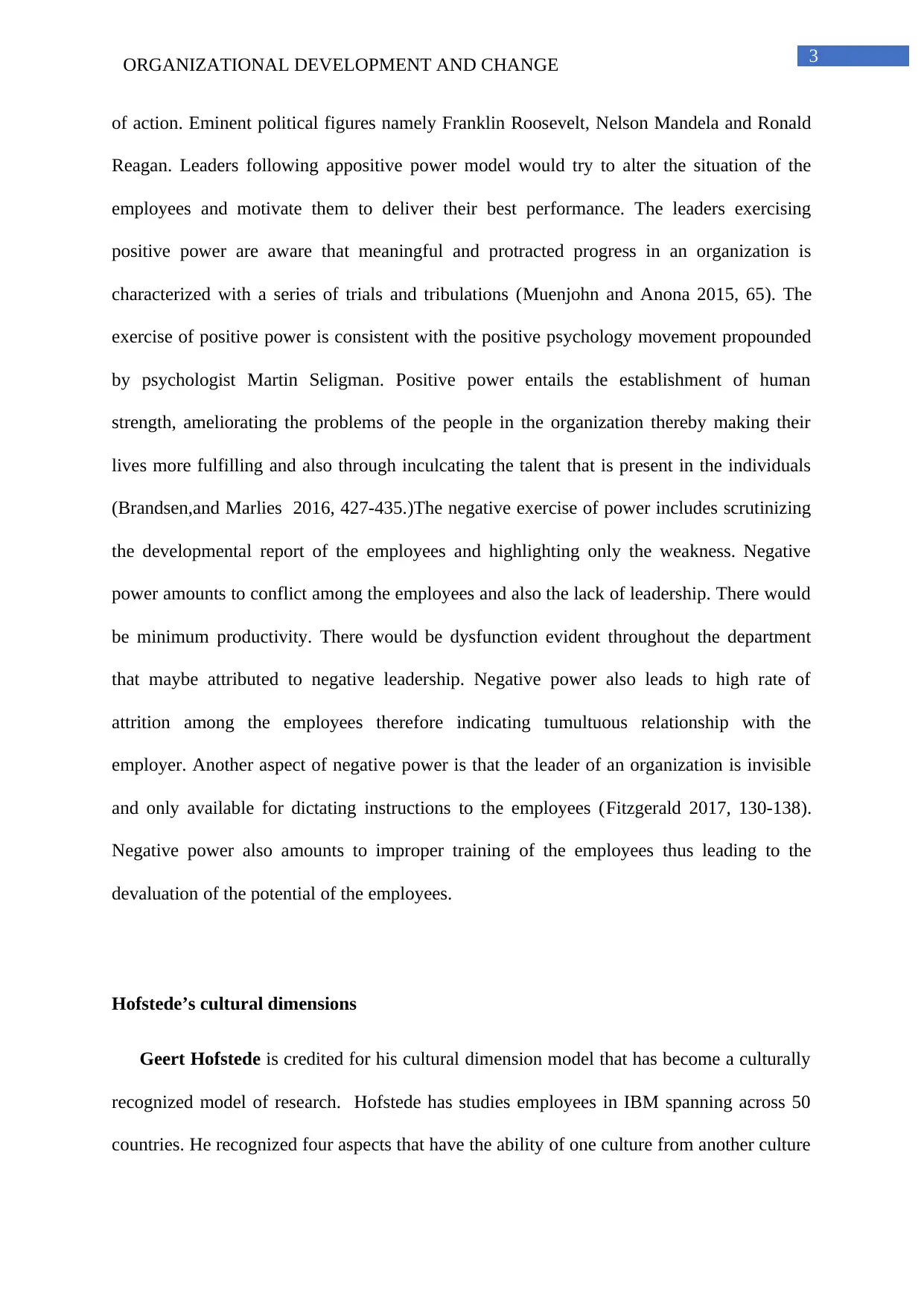
3ORGANIZATIONAL DEVELOPMENT AND CHANGE
of action. Eminent political figures namely Franklin Roosevelt, Nelson Mandela and Ronald
Reagan. Leaders following appositive power model would try to alter the situation of the
employees and motivate them to deliver their best performance. The leaders exercising
positive power are aware that meaningful and protracted progress in an organization is
characterized with a series of trials and tribulations (Muenjohn and Anona 2015, 65). The
exercise of positive power is consistent with the positive psychology movement propounded
by psychologist Martin Seligman. Positive power entails the establishment of human
strength, ameliorating the problems of the people in the organization thereby making their
lives more fulfilling and also through inculcating the talent that is present in the individuals
(Brandsen,and Marlies 2016, 427-435.)The negative exercise of power includes scrutinizing
the developmental report of the employees and highlighting only the weakness. Negative
power amounts to conflict among the employees and also the lack of leadership. There would
be minimum productivity. There would be dysfunction evident throughout the department
that maybe attributed to negative leadership. Negative power also leads to high rate of
attrition among the employees therefore indicating tumultuous relationship with the
employer. Another aspect of negative power is that the leader of an organization is invisible
and only available for dictating instructions to the employees (Fitzgerald 2017, 130-138).
Negative power also amounts to improper training of the employees thus leading to the
devaluation of the potential of the employees.
Hofstede’s cultural dimensions
Geert Hofstede is credited for his cultural dimension model that has become a culturally
recognized model of research. Hofstede has studies employees in IBM spanning across 50
countries. He recognized four aspects that have the ability of one culture from another culture
of action. Eminent political figures namely Franklin Roosevelt, Nelson Mandela and Ronald
Reagan. Leaders following appositive power model would try to alter the situation of the
employees and motivate them to deliver their best performance. The leaders exercising
positive power are aware that meaningful and protracted progress in an organization is
characterized with a series of trials and tribulations (Muenjohn and Anona 2015, 65). The
exercise of positive power is consistent with the positive psychology movement propounded
by psychologist Martin Seligman. Positive power entails the establishment of human
strength, ameliorating the problems of the people in the organization thereby making their
lives more fulfilling and also through inculcating the talent that is present in the individuals
(Brandsen,and Marlies 2016, 427-435.)The negative exercise of power includes scrutinizing
the developmental report of the employees and highlighting only the weakness. Negative
power amounts to conflict among the employees and also the lack of leadership. There would
be minimum productivity. There would be dysfunction evident throughout the department
that maybe attributed to negative leadership. Negative power also leads to high rate of
attrition among the employees therefore indicating tumultuous relationship with the
employer. Another aspect of negative power is that the leader of an organization is invisible
and only available for dictating instructions to the employees (Fitzgerald 2017, 130-138).
Negative power also amounts to improper training of the employees thus leading to the
devaluation of the potential of the employees.
Hofstede’s cultural dimensions
Geert Hofstede is credited for his cultural dimension model that has become a culturally
recognized model of research. Hofstede has studies employees in IBM spanning across 50
countries. He recognized four aspects that have the ability of one culture from another culture
Paraphrase This Document
Need a fresh take? Get an instant paraphrase of this document with our AI Paraphraser
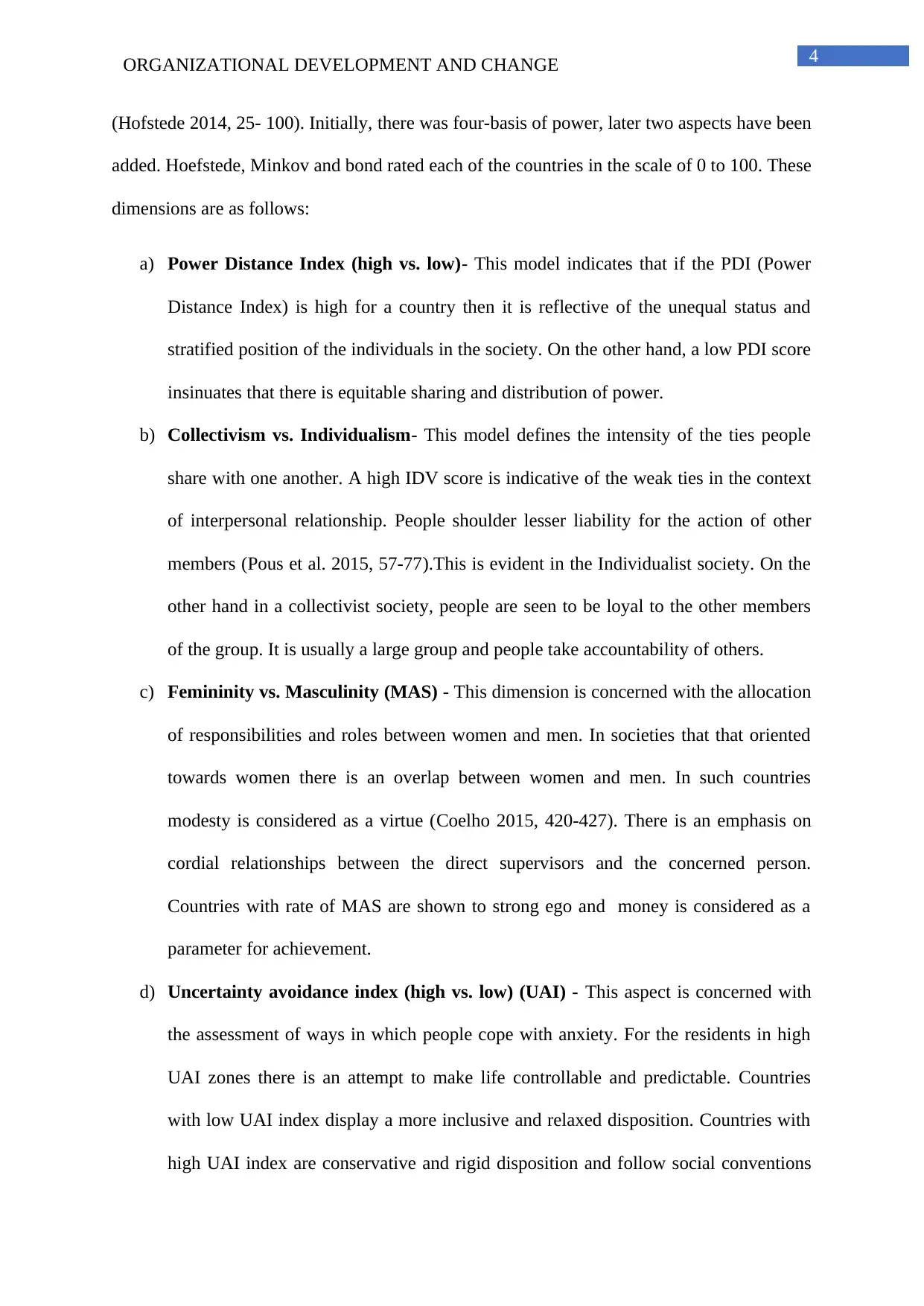
4ORGANIZATIONAL DEVELOPMENT AND CHANGE
(Hofstede 2014, 25- 100). Initially, there was four-basis of power, later two aspects have been
added. Hoefstede, Minkov and bond rated each of the countries in the scale of 0 to 100. These
dimensions are as follows:
a) Power Distance Index (high vs. low)- This model indicates that if the PDI (Power
Distance Index) is high for a country then it is reflective of the unequal status and
stratified position of the individuals in the society. On the other hand, a low PDI score
insinuates that there is equitable sharing and distribution of power.
b) Collectivism vs. Individualism- This model defines the intensity of the ties people
share with one another. A high IDV score is indicative of the weak ties in the context
of interpersonal relationship. People shoulder lesser liability for the action of other
members (Pous et al. 2015, 57-77).This is evident in the Individualist society. On the
other hand in a collectivist society, people are seen to be loyal to the other members
of the group. It is usually a large group and people take accountability of others.
c) Femininity vs. Masculinity (MAS) - This dimension is concerned with the allocation
of responsibilities and roles between women and men. In societies that that oriented
towards women there is an overlap between women and men. In such countries
modesty is considered as a virtue (Coelho 2015, 420-427). There is an emphasis on
cordial relationships between the direct supervisors and the concerned person.
Countries with rate of MAS are shown to strong ego and money is considered as a
parameter for achievement.
d) Uncertainty avoidance index (high vs. low) (UAI) - This aspect is concerned with
the assessment of ways in which people cope with anxiety. For the residents in high
UAI zones there is an attempt to make life controllable and predictable. Countries
with low UAI index display a more inclusive and relaxed disposition. Countries with
high UAI index are conservative and rigid disposition and follow social conventions
(Hofstede 2014, 25- 100). Initially, there was four-basis of power, later two aspects have been
added. Hoefstede, Minkov and bond rated each of the countries in the scale of 0 to 100. These
dimensions are as follows:
a) Power Distance Index (high vs. low)- This model indicates that if the PDI (Power
Distance Index) is high for a country then it is reflective of the unequal status and
stratified position of the individuals in the society. On the other hand, a low PDI score
insinuates that there is equitable sharing and distribution of power.
b) Collectivism vs. Individualism- This model defines the intensity of the ties people
share with one another. A high IDV score is indicative of the weak ties in the context
of interpersonal relationship. People shoulder lesser liability for the action of other
members (Pous et al. 2015, 57-77).This is evident in the Individualist society. On the
other hand in a collectivist society, people are seen to be loyal to the other members
of the group. It is usually a large group and people take accountability of others.
c) Femininity vs. Masculinity (MAS) - This dimension is concerned with the allocation
of responsibilities and roles between women and men. In societies that that oriented
towards women there is an overlap between women and men. In such countries
modesty is considered as a virtue (Coelho 2015, 420-427). There is an emphasis on
cordial relationships between the direct supervisors and the concerned person.
Countries with rate of MAS are shown to strong ego and money is considered as a
parameter for achievement.
d) Uncertainty avoidance index (high vs. low) (UAI) - This aspect is concerned with
the assessment of ways in which people cope with anxiety. For the residents in high
UAI zones there is an attempt to make life controllable and predictable. Countries
with low UAI index display a more inclusive and relaxed disposition. Countries with
high UAI index are conservative and rigid disposition and follow social conventions
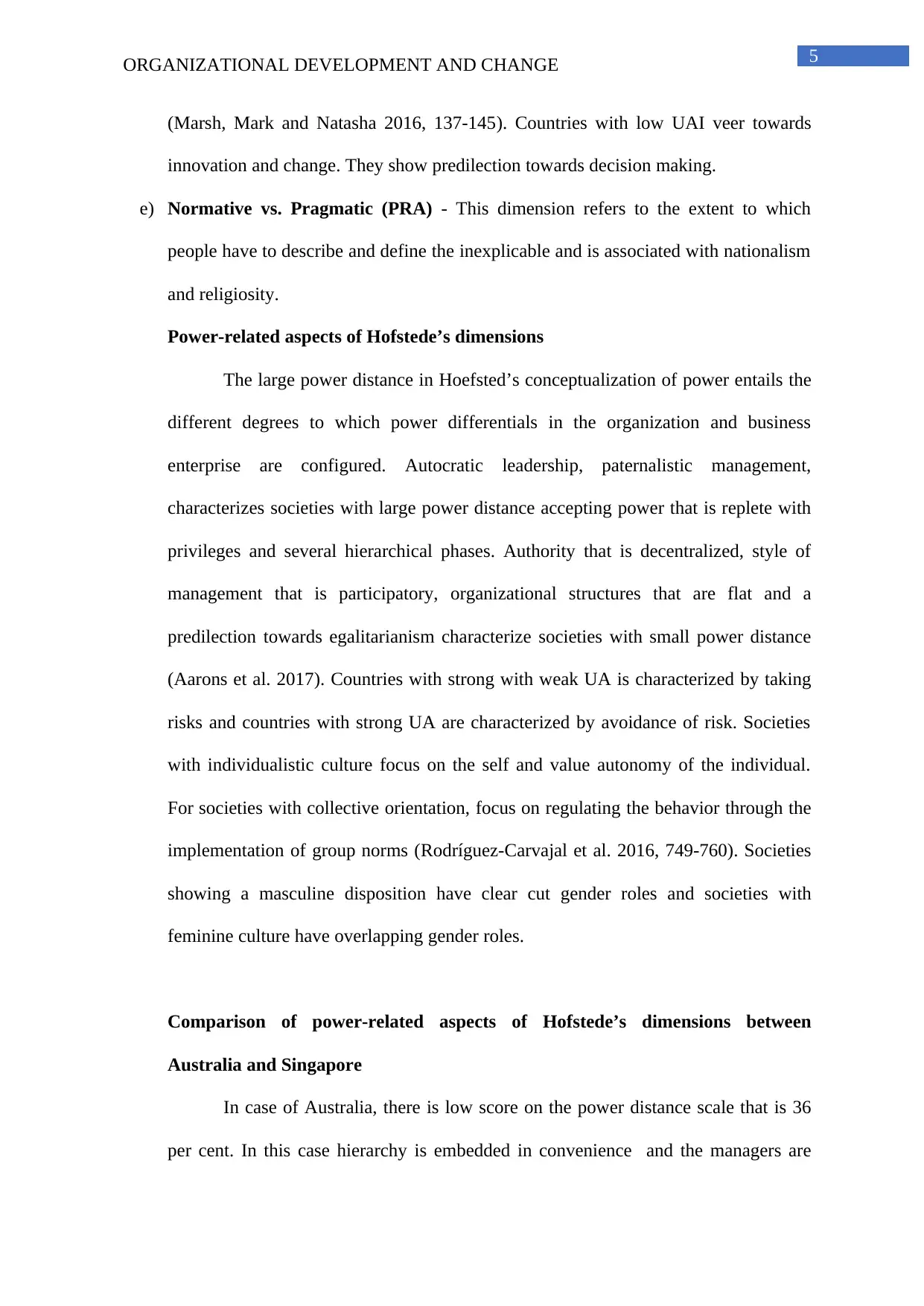
5ORGANIZATIONAL DEVELOPMENT AND CHANGE
(Marsh, Mark and Natasha 2016, 137-145). Countries with low UAI veer towards
innovation and change. They show predilection towards decision making.
e) Normative vs. Pragmatic (PRA) - This dimension refers to the extent to which
people have to describe and define the inexplicable and is associated with nationalism
and religiosity.
Power-related aspects of Hofstede’s dimensions
The large power distance in Hoefsted’s conceptualization of power entails the
different degrees to which power differentials in the organization and business
enterprise are configured. Autocratic leadership, paternalistic management,
characterizes societies with large power distance accepting power that is replete with
privileges and several hierarchical phases. Authority that is decentralized, style of
management that is participatory, organizational structures that are flat and a
predilection towards egalitarianism characterize societies with small power distance
(Aarons et al. 2017). Countries with strong with weak UA is characterized by taking
risks and countries with strong UA are characterized by avoidance of risk. Societies
with individualistic culture focus on the self and value autonomy of the individual.
For societies with collective orientation, focus on regulating the behavior through the
implementation of group norms (Rodríguez-Carvajal et al. 2016, 749-760). Societies
showing a masculine disposition have clear cut gender roles and societies with
feminine culture have overlapping gender roles.
Comparison of power-related aspects of Hofstede’s dimensions between
Australia and Singapore
In case of Australia, there is low score on the power distance scale that is 36
per cent. In this case hierarchy is embedded in convenience and the managers are
(Marsh, Mark and Natasha 2016, 137-145). Countries with low UAI veer towards
innovation and change. They show predilection towards decision making.
e) Normative vs. Pragmatic (PRA) - This dimension refers to the extent to which
people have to describe and define the inexplicable and is associated with nationalism
and religiosity.
Power-related aspects of Hofstede’s dimensions
The large power distance in Hoefsted’s conceptualization of power entails the
different degrees to which power differentials in the organization and business
enterprise are configured. Autocratic leadership, paternalistic management,
characterizes societies with large power distance accepting power that is replete with
privileges and several hierarchical phases. Authority that is decentralized, style of
management that is participatory, organizational structures that are flat and a
predilection towards egalitarianism characterize societies with small power distance
(Aarons et al. 2017). Countries with strong with weak UA is characterized by taking
risks and countries with strong UA are characterized by avoidance of risk. Societies
with individualistic culture focus on the self and value autonomy of the individual.
For societies with collective orientation, focus on regulating the behavior through the
implementation of group norms (Rodríguez-Carvajal et al. 2016, 749-760). Societies
showing a masculine disposition have clear cut gender roles and societies with
feminine culture have overlapping gender roles.
Comparison of power-related aspects of Hofstede’s dimensions between
Australia and Singapore
In case of Australia, there is low score on the power distance scale that is 36
per cent. In this case hierarchy is embedded in convenience and the managers are
⊘ This is a preview!⊘
Do you want full access?
Subscribe today to unlock all pages.

Trusted by 1+ million students worldwide
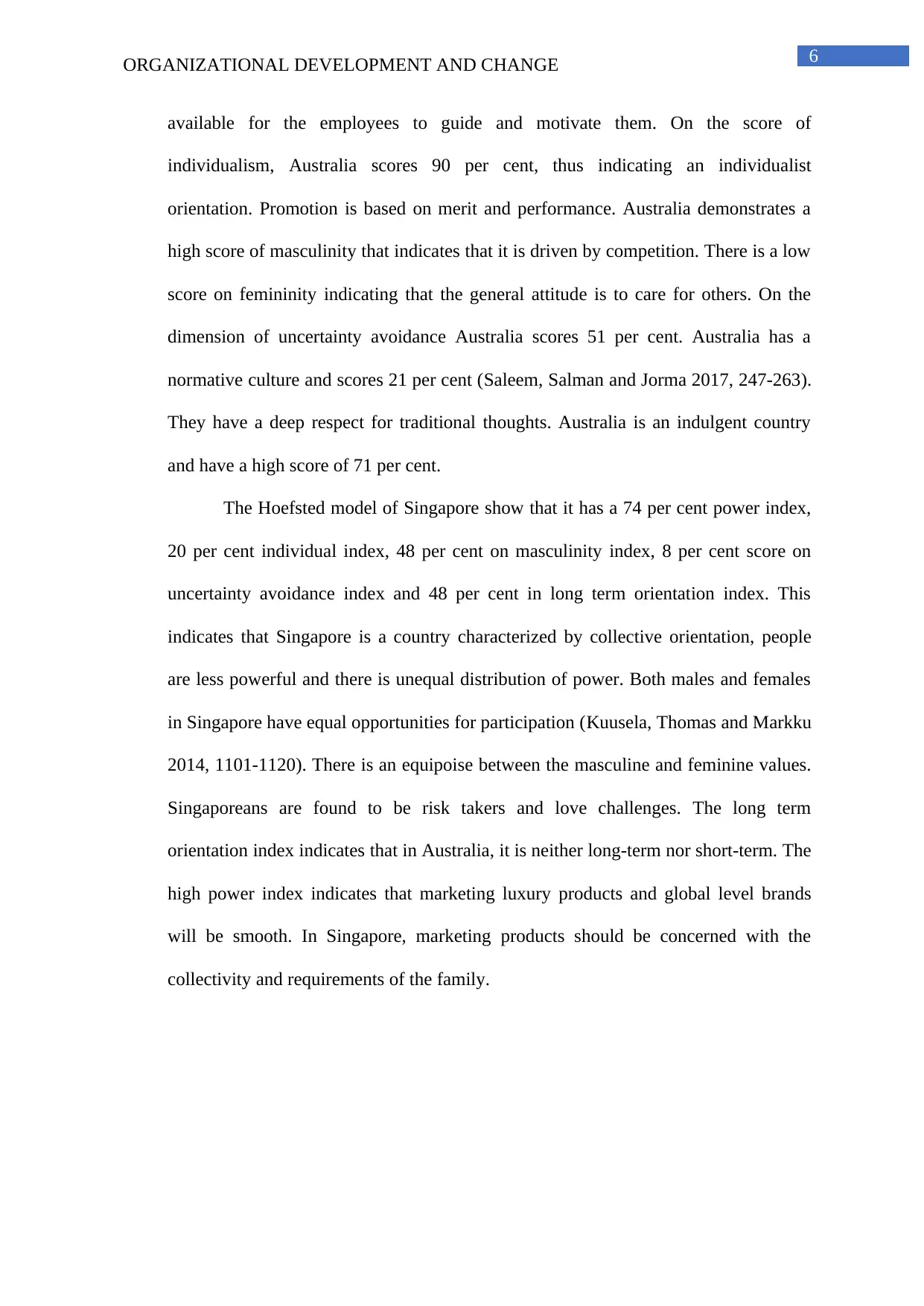
6ORGANIZATIONAL DEVELOPMENT AND CHANGE
available for the employees to guide and motivate them. On the score of
individualism, Australia scores 90 per cent, thus indicating an individualist
orientation. Promotion is based on merit and performance. Australia demonstrates a
high score of masculinity that indicates that it is driven by competition. There is a low
score on femininity indicating that the general attitude is to care for others. On the
dimension of uncertainty avoidance Australia scores 51 per cent. Australia has a
normative culture and scores 21 per cent (Saleem, Salman and Jorma 2017, 247-263).
They have a deep respect for traditional thoughts. Australia is an indulgent country
and have a high score of 71 per cent.
The Hoefsted model of Singapore show that it has a 74 per cent power index,
20 per cent individual index, 48 per cent on masculinity index, 8 per cent score on
uncertainty avoidance index and 48 per cent in long term orientation index. This
indicates that Singapore is a country characterized by collective orientation, people
are less powerful and there is unequal distribution of power. Both males and females
in Singapore have equal opportunities for participation (Kuusela, Thomas and Markku
2014, 1101-1120). There is an equipoise between the masculine and feminine values.
Singaporeans are found to be risk takers and love challenges. The long term
orientation index indicates that in Australia, it is neither long-term nor short-term. The
high power index indicates that marketing luxury products and global level brands
will be smooth. In Singapore, marketing products should be concerned with the
collectivity and requirements of the family.
available for the employees to guide and motivate them. On the score of
individualism, Australia scores 90 per cent, thus indicating an individualist
orientation. Promotion is based on merit and performance. Australia demonstrates a
high score of masculinity that indicates that it is driven by competition. There is a low
score on femininity indicating that the general attitude is to care for others. On the
dimension of uncertainty avoidance Australia scores 51 per cent. Australia has a
normative culture and scores 21 per cent (Saleem, Salman and Jorma 2017, 247-263).
They have a deep respect for traditional thoughts. Australia is an indulgent country
and have a high score of 71 per cent.
The Hoefsted model of Singapore show that it has a 74 per cent power index,
20 per cent individual index, 48 per cent on masculinity index, 8 per cent score on
uncertainty avoidance index and 48 per cent in long term orientation index. This
indicates that Singapore is a country characterized by collective orientation, people
are less powerful and there is unequal distribution of power. Both males and females
in Singapore have equal opportunities for participation (Kuusela, Thomas and Markku
2014, 1101-1120). There is an equipoise between the masculine and feminine values.
Singaporeans are found to be risk takers and love challenges. The long term
orientation index indicates that in Australia, it is neither long-term nor short-term. The
high power index indicates that marketing luxury products and global level brands
will be smooth. In Singapore, marketing products should be concerned with the
collectivity and requirements of the family.
Paraphrase This Document
Need a fresh take? Get an instant paraphrase of this document with our AI Paraphraser
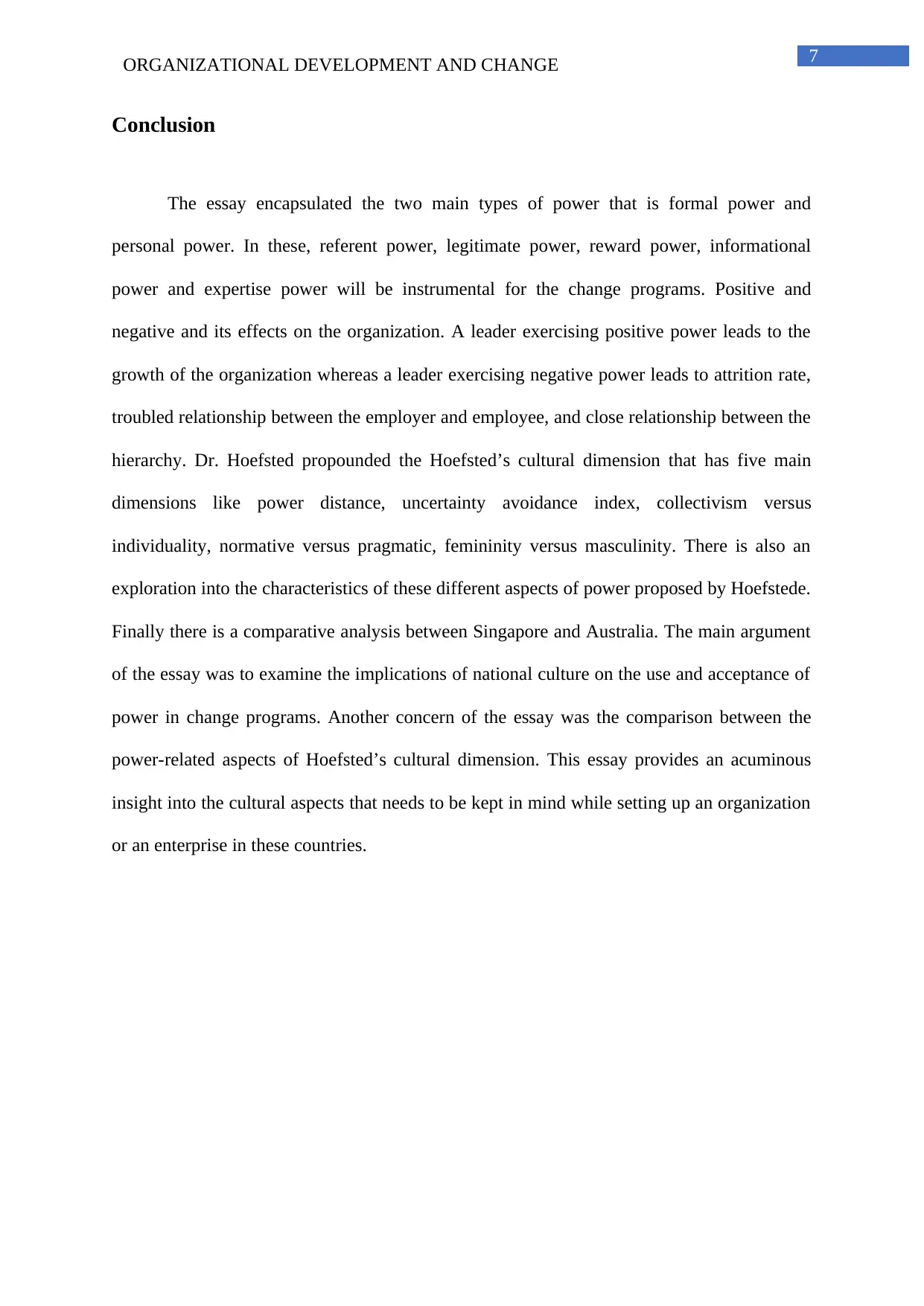
7ORGANIZATIONAL DEVELOPMENT AND CHANGE
Conclusion
The essay encapsulated the two main types of power that is formal power and
personal power. In these, referent power, legitimate power, reward power, informational
power and expertise power will be instrumental for the change programs. Positive and
negative and its effects on the organization. A leader exercising positive power leads to the
growth of the organization whereas a leader exercising negative power leads to attrition rate,
troubled relationship between the employer and employee, and close relationship between the
hierarchy. Dr. Hoefsted propounded the Hoefsted’s cultural dimension that has five main
dimensions like power distance, uncertainty avoidance index, collectivism versus
individuality, normative versus pragmatic, femininity versus masculinity. There is also an
exploration into the characteristics of these different aspects of power proposed by Hoefstede.
Finally there is a comparative analysis between Singapore and Australia. The main argument
of the essay was to examine the implications of national culture on the use and acceptance of
power in change programs. Another concern of the essay was the comparison between the
power-related aspects of Hoefsted’s cultural dimension. This essay provides an acuminous
insight into the cultural aspects that needs to be kept in mind while setting up an organization
or an enterprise in these countries.
Conclusion
The essay encapsulated the two main types of power that is formal power and
personal power. In these, referent power, legitimate power, reward power, informational
power and expertise power will be instrumental for the change programs. Positive and
negative and its effects on the organization. A leader exercising positive power leads to the
growth of the organization whereas a leader exercising negative power leads to attrition rate,
troubled relationship between the employer and employee, and close relationship between the
hierarchy. Dr. Hoefsted propounded the Hoefsted’s cultural dimension that has five main
dimensions like power distance, uncertainty avoidance index, collectivism versus
individuality, normative versus pragmatic, femininity versus masculinity. There is also an
exploration into the characteristics of these different aspects of power proposed by Hoefstede.
Finally there is a comparative analysis between Singapore and Australia. The main argument
of the essay was to examine the implications of national culture on the use and acceptance of
power in change programs. Another concern of the essay was the comparison between the
power-related aspects of Hoefsted’s cultural dimension. This essay provides an acuminous
insight into the cultural aspects that needs to be kept in mind while setting up an organization
or an enterprise in these countries.
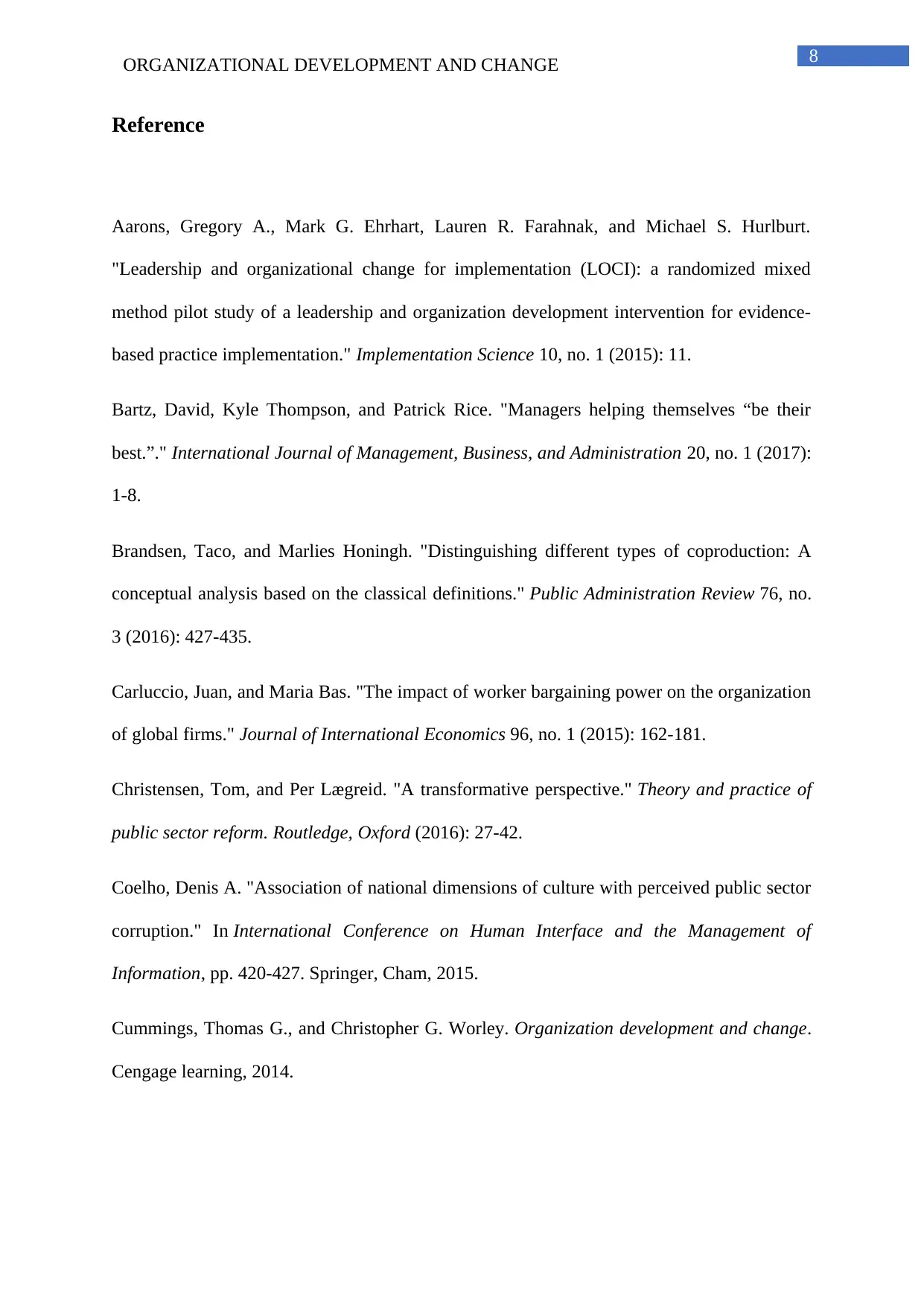
8ORGANIZATIONAL DEVELOPMENT AND CHANGE
Reference
Aarons, Gregory A., Mark G. Ehrhart, Lauren R. Farahnak, and Michael S. Hurlburt.
"Leadership and organizational change for implementation (LOCI): a randomized mixed
method pilot study of a leadership and organization development intervention for evidence-
based practice implementation." Implementation Science 10, no. 1 (2015): 11.
Bartz, David, Kyle Thompson, and Patrick Rice. "Managers helping themselves “be their
best.”." International Journal of Management, Business, and Administration 20, no. 1 (2017):
1-8.
Brandsen, Taco, and Marlies Honingh. "Distinguishing different types of coproduction: A
conceptual analysis based on the classical definitions." Public Administration Review 76, no.
3 (2016): 427-435.
Carluccio, Juan, and Maria Bas. "The impact of worker bargaining power on the organization
of global firms." Journal of International Economics 96, no. 1 (2015): 162-181.
Christensen, Tom, and Per Lægreid. "A transformative perspective." Theory and practice of
public sector reform. Routledge, Oxford (2016): 27-42.
Coelho, Denis A. "Association of national dimensions of culture with perceived public sector
corruption." In International Conference on Human Interface and the Management of
Information, pp. 420-427. Springer, Cham, 2015.
Cummings, Thomas G., and Christopher G. Worley. Organization development and change.
Cengage learning, 2014.
Reference
Aarons, Gregory A., Mark G. Ehrhart, Lauren R. Farahnak, and Michael S. Hurlburt.
"Leadership and organizational change for implementation (LOCI): a randomized mixed
method pilot study of a leadership and organization development intervention for evidence-
based practice implementation." Implementation Science 10, no. 1 (2015): 11.
Bartz, David, Kyle Thompson, and Patrick Rice. "Managers helping themselves “be their
best.”." International Journal of Management, Business, and Administration 20, no. 1 (2017):
1-8.
Brandsen, Taco, and Marlies Honingh. "Distinguishing different types of coproduction: A
conceptual analysis based on the classical definitions." Public Administration Review 76, no.
3 (2016): 427-435.
Carluccio, Juan, and Maria Bas. "The impact of worker bargaining power on the organization
of global firms." Journal of International Economics 96, no. 1 (2015): 162-181.
Christensen, Tom, and Per Lægreid. "A transformative perspective." Theory and practice of
public sector reform. Routledge, Oxford (2016): 27-42.
Coelho, Denis A. "Association of national dimensions of culture with perceived public sector
corruption." In International Conference on Human Interface and the Management of
Information, pp. 420-427. Springer, Cham, 2015.
Cummings, Thomas G., and Christopher G. Worley. Organization development and change.
Cengage learning, 2014.
⊘ This is a preview!⊘
Do you want full access?
Subscribe today to unlock all pages.

Trusted by 1+ million students worldwide
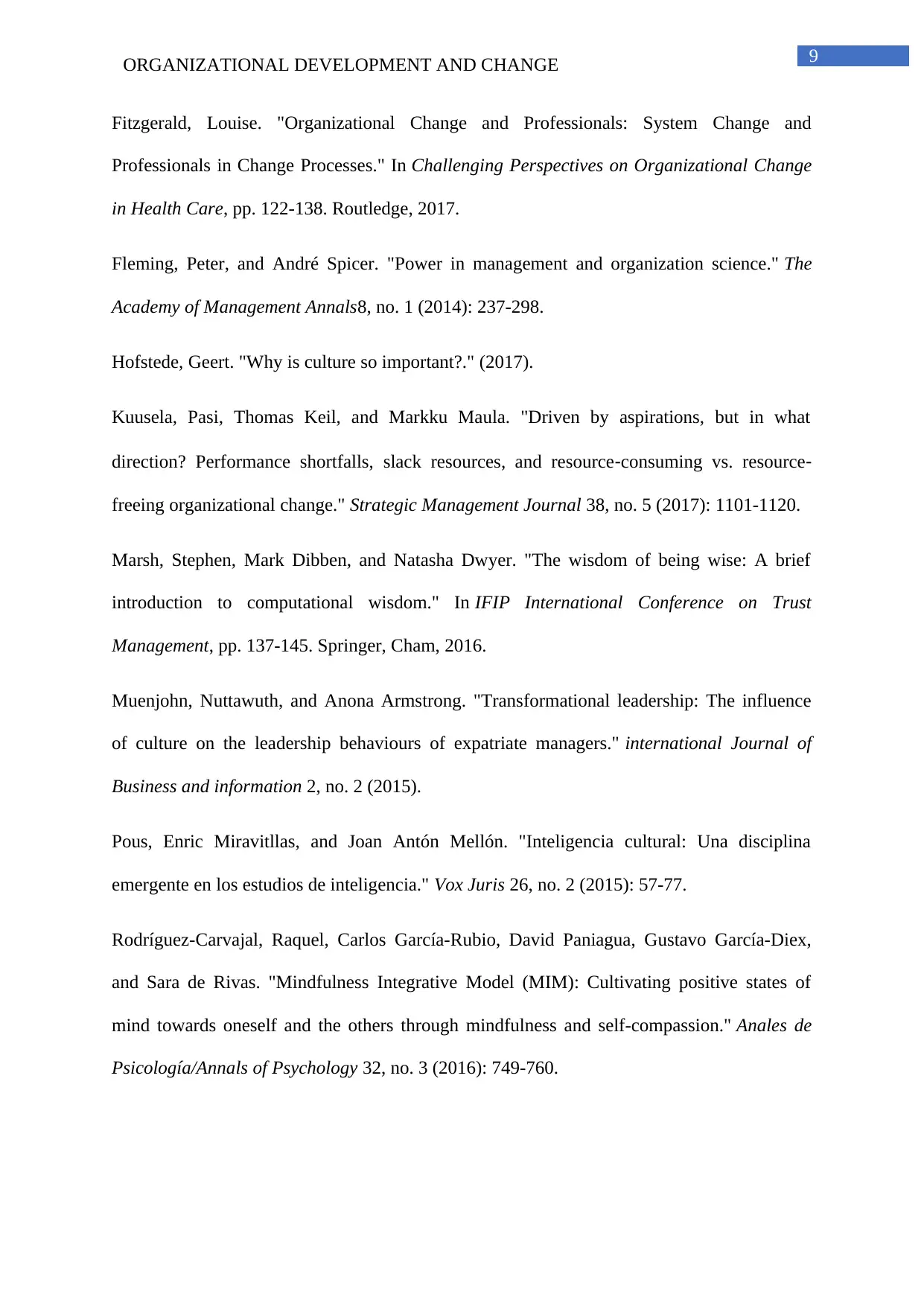
9ORGANIZATIONAL DEVELOPMENT AND CHANGE
Fitzgerald, Louise. "Organizational Change and Professionals: System Change and
Professionals in Change Processes." In Challenging Perspectives on Organizational Change
in Health Care, pp. 122-138. Routledge, 2017.
Fleming, Peter, and André Spicer. "Power in management and organization science." The
Academy of Management Annals8, no. 1 (2014): 237-298.
Hofstede, Geert. "Why is culture so important?." (2017).
Kuusela, Pasi, Thomas Keil, and Markku Maula. "Driven by aspirations, but in what
direction? Performance shortfalls, slack resources, and resource‐consuming vs. resource‐
freeing organizational change." Strategic Management Journal 38, no. 5 (2017): 1101-1120.
Marsh, Stephen, Mark Dibben, and Natasha Dwyer. "The wisdom of being wise: A brief
introduction to computational wisdom." In IFIP International Conference on Trust
Management, pp. 137-145. Springer, Cham, 2016.
Muenjohn, Nuttawuth, and Anona Armstrong. "Transformational leadership: The influence
of culture on the leadership behaviours of expatriate managers." international Journal of
Business and information 2, no. 2 (2015).
Pous, Enric Miravitllas, and Joan Antón Mellón. "Inteligencia cultural: Una disciplina
emergente en los estudios de inteligencia." Vox Juris 26, no. 2 (2015): 57-77.
Rodríguez-Carvajal, Raquel, Carlos García-Rubio, David Paniagua, Gustavo García-Diex,
and Sara de Rivas. "Mindfulness Integrative Model (MIM): Cultivating positive states of
mind towards oneself and the others through mindfulness and self-compassion." Anales de
Psicología/Annals of Psychology 32, no. 3 (2016): 749-760.
Fitzgerald, Louise. "Organizational Change and Professionals: System Change and
Professionals in Change Processes." In Challenging Perspectives on Organizational Change
in Health Care, pp. 122-138. Routledge, 2017.
Fleming, Peter, and André Spicer. "Power in management and organization science." The
Academy of Management Annals8, no. 1 (2014): 237-298.
Hofstede, Geert. "Why is culture so important?." (2017).
Kuusela, Pasi, Thomas Keil, and Markku Maula. "Driven by aspirations, but in what
direction? Performance shortfalls, slack resources, and resource‐consuming vs. resource‐
freeing organizational change." Strategic Management Journal 38, no. 5 (2017): 1101-1120.
Marsh, Stephen, Mark Dibben, and Natasha Dwyer. "The wisdom of being wise: A brief
introduction to computational wisdom." In IFIP International Conference on Trust
Management, pp. 137-145. Springer, Cham, 2016.
Muenjohn, Nuttawuth, and Anona Armstrong. "Transformational leadership: The influence
of culture on the leadership behaviours of expatriate managers." international Journal of
Business and information 2, no. 2 (2015).
Pous, Enric Miravitllas, and Joan Antón Mellón. "Inteligencia cultural: Una disciplina
emergente en los estudios de inteligencia." Vox Juris 26, no. 2 (2015): 57-77.
Rodríguez-Carvajal, Raquel, Carlos García-Rubio, David Paniagua, Gustavo García-Diex,
and Sara de Rivas. "Mindfulness Integrative Model (MIM): Cultivating positive states of
mind towards oneself and the others through mindfulness and self-compassion." Anales de
Psicología/Annals of Psychology 32, no. 3 (2016): 749-760.
Paraphrase This Document
Need a fresh take? Get an instant paraphrase of this document with our AI Paraphraser
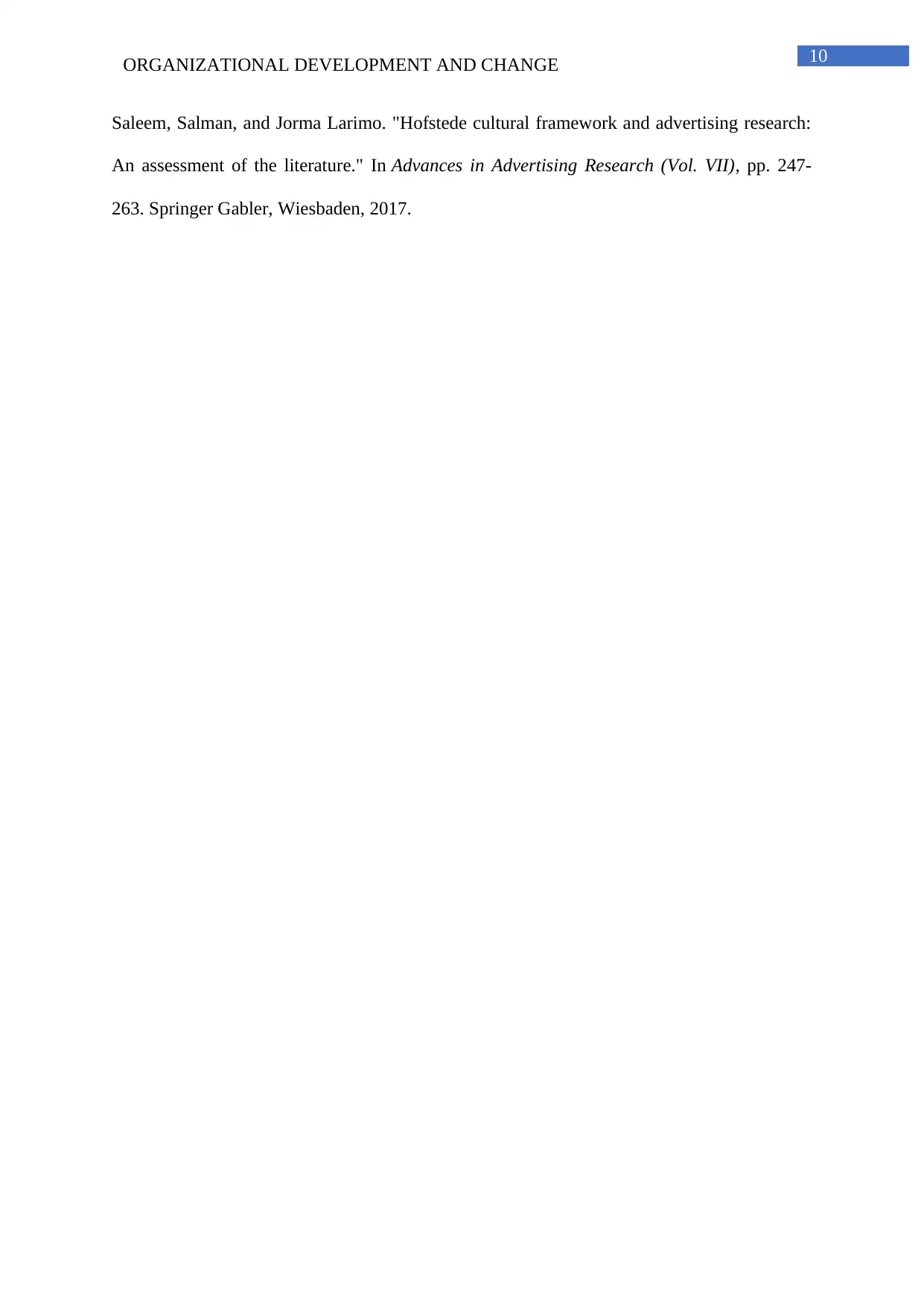
10ORGANIZATIONAL DEVELOPMENT AND CHANGE
Saleem, Salman, and Jorma Larimo. "Hofstede cultural framework and advertising research:
An assessment of the literature." In Advances in Advertising Research (Vol. VII), pp. 247-
263. Springer Gabler, Wiesbaden, 2017.
Saleem, Salman, and Jorma Larimo. "Hofstede cultural framework and advertising research:
An assessment of the literature." In Advances in Advertising Research (Vol. VII), pp. 247-
263. Springer Gabler, Wiesbaden, 2017.
1 out of 11
Related Documents
Your All-in-One AI-Powered Toolkit for Academic Success.
+13062052269
info@desklib.com
Available 24*7 on WhatsApp / Email
![[object Object]](/_next/static/media/star-bottom.7253800d.svg)
Unlock your academic potential
Copyright © 2020–2025 A2Z Services. All Rights Reserved. Developed and managed by ZUCOL.





